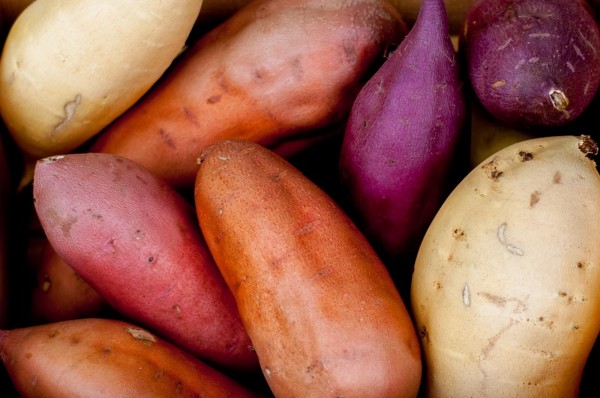Here is a fact that my daughter will immediately call “bizarre”. Sweet potatoes are not potatoes and Yam is not sweet potato!
In fact all of these similar looking tubers are very different, Yam was brought to the west from Africa where it’s known as Nyami. Then why is orange fleshed sweet potato known as Yam? It might something to do with marketing. When orange sweet potatoes were introduced in the south, producers, business men and shipper had to distinguish them from the the more traditional white flesh types. So the African word Nyami was adopted into its north american form as Yam.
Now the term has stayed and is almost used interchangeably.
Regardless of the name, sweet potatoes are one of nature’s unsurpassed source of healthy nutrients our body needs. Micro nutrients like Vitamin A (beta carotene) are packed into these tubers. So much so that some studies have established it to be a better source for Vitamin A than green leafy vegetables. Yet beta carotene just begins to tell the story of sweet potatoes. Have you come across sweet potatoes with deep purple flesh? Anthocyanins, an important antioxidant is abundant in purple varieties.
Recent research has shown that particularly when passing through our digestive tract, sweet potato cyanidins and peonidins and other color-related phytonutrients may be able to lower the potential health risk posed by heavy metals and oxygen radicals. That risk reduction might be important not only for individuals at risk of digestive tract problems but for people to reduce the potential risk posed by the presence of heavy metal residues (like small amounts of mercury or cadmium or arsenic) in their diet.
Considering it’s starchy vegetable, most people stay away from sweet potatoes thinking that it will contribute to their weight or fat. Reality is actually far from it. What’s fascinating about sweet potatoes is their ability to improve blood sugar regulation. Recent research has shown that extracts from sweet potatoes can significantly increase blood levels of adiponectin in persons with type 2 diabetes. Adiponectin is a protein hormone produced by our fat cells, and it serves as an important modifier of insulin metabolism. Persons with poorly-regulated insulin metabolism and insulin insensitivity tend to have lower levels of adiponectin, and persons with healthier insulin metabolism tend to have higher levels.
When consuming sweet potatoes, you can increase availability of some nutrients by include some fats. By just adding 1 tbsp of virgin olive oil in mashed sweet potato, you can increase availability of beta carotene significantly. You can also cut them into 1/2-inch slices and steam for just 7 minutes, it will not only bring out their great flavor but will help to maximize their nutritional value. You can add some olive oil, cinnamon, nutmeg, and/or cloves for extra flavor and nutrition.
Other than my daughter’s favorite meal of mashed sweet potatoes in milk, I frequently make a very simple indian dessert (recipe below) that you can try, and share your comments.
Ingredients: 5 large sweet potatoes, ½ cup ghee, 1 cup jaggery, 1 tsp. cardamom powder
- Steam, remove skins, and mash the sweet potatoes. Heat ghee in saucepan, over medium flame, until hot.
- Add the mashed sweet potatoes and stir for 10 minutes. Add sugar, stir, and cook for 5 minutes.
- Turn off flame and add cardamom powder and mix. Remove from heat and serve.
